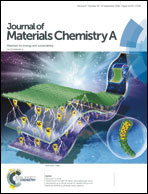Vacuum-assisted layer-by-layer superhydrophobic carbon nanotube films with electrothermal and photothermal effects for deicing and controllable manipulation†
Abstract
The fabrication of functional superhydrophobic surfaces that combine various performances for the emerging application horizons such as deicing and self-propelled machines remains challenging. In the present work, a vacuum-assisted layer-by-layer superhydrophobic carbon nanotube film integrating the electrothermal effect with photothermal performance was fabricated by vacuum-assembling a multilayer of carboxylated and aminated multiwalled carbon nanotubes ((MWCNTs-COOH/MWCNTs-NH2)n), followed by transferring onto a desired substrate coated with an ethylene-vinyl acetate (EVA) copolymer and modifying with n-octadecylamine (ODA) through the amidation reaction. Using a filtration membrane as a template, the multiwalled carbon nanotube (MWCNT) film displayed micro–nano hierarchical roughness in support of superhydrophobicity with a CA of 165°. Importantly, the MWCNT film also served as a functional heater under an applied voltage or different light sources. Utilizing the electrothermal effect and water repellency, the superhydrophobic MWCNT film was successfully applied in high-speed deicing. Additionally, combining the surface tension gradients generated by photothermal performance with reduced drag on the water surface, the superhydrophobic MWCNT film was propelled to move linearly, curvilinearly, and rotationally. These findings conceivably stand out as a new tool to fabricate functional superhydrophobic films with electrothermal and photothermal effects for various potential applications.



 Please wait while we load your content...
Please wait while we load your content...